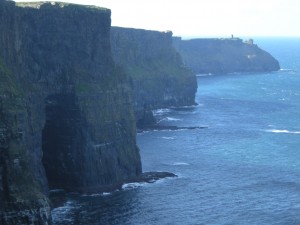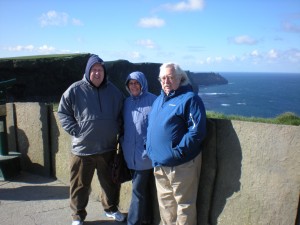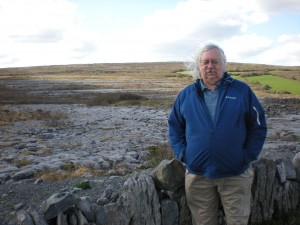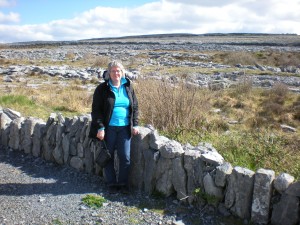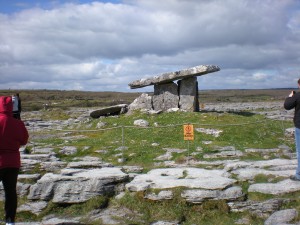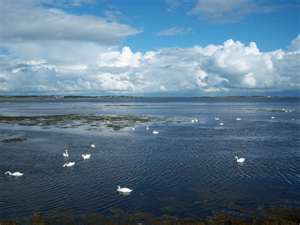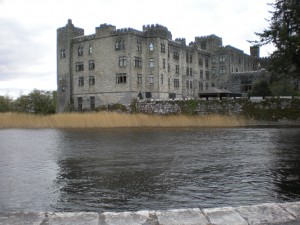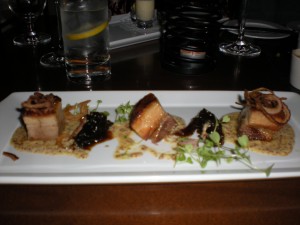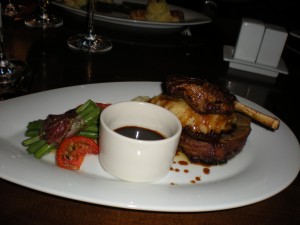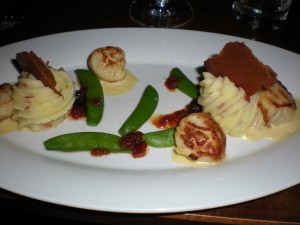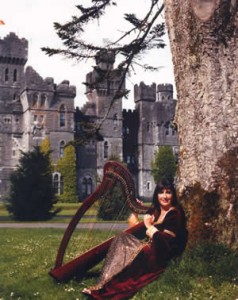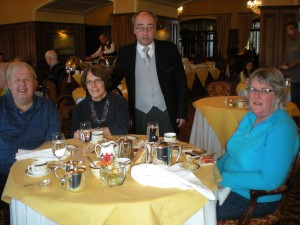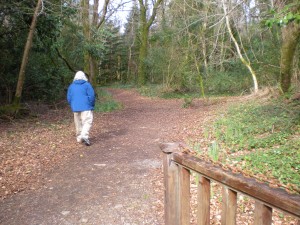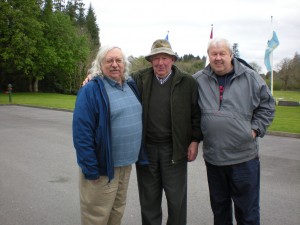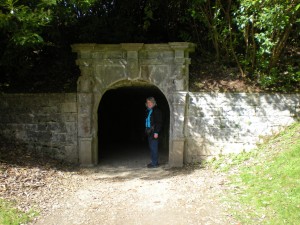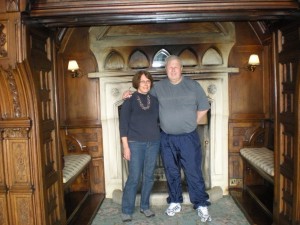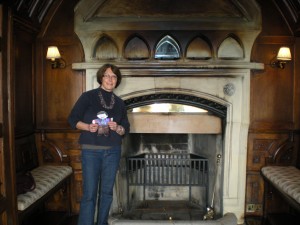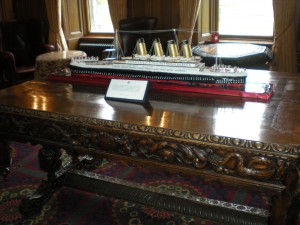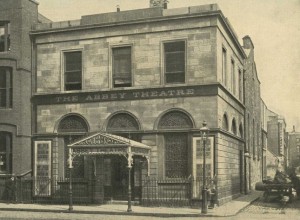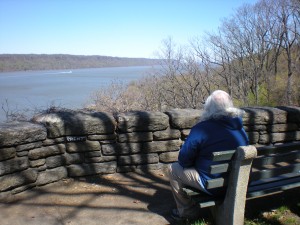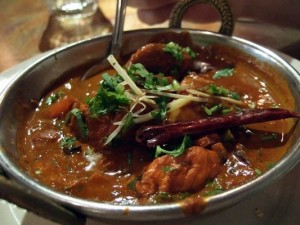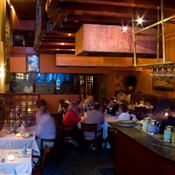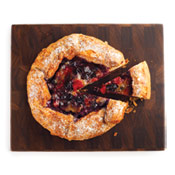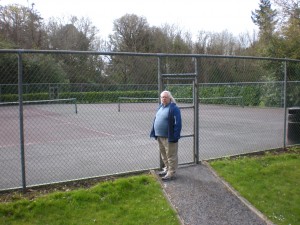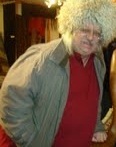- Dave splashing off the Cliffs of Moher
April 4th –Galway, Ashford Castle
Cliffs of Moher (moore) are located at the Southwestern edge of the Burren. The highest point is over 700 ft (near O’Brien’s tower) O’Brien’s Tower was built in 1835 near the midpoint of the cliffs by Cornelius O’Brien to impress females (so the legend goes).
From this vantage point we had an incredible clear day and could see the Aran Islands in Galway Bay, Maumturks and Twelve Pins mountain ranges to the North. The cliffs were named after an old fort (Ft. Moher demolished in 1808) that once stood on Hag’s Head (the cliffs are about 300 feet at this point). The Aran Islands received notoriety when Mrs. Clancy sent her singing sons sweaters made from the wool form Aran Island to help combat the ice and snow storms in New York. Their manager seized on the idea and they became the costumes for his new act, Tommy Makem and the Clancy Brothers.
The Burren —
I was able to purchase this prime farmland for a few euros. Does anyone know how to grow rocks?
The Burren is an ecological marvel located roughly between Lahinch to the south and the southern part of Galway Bay to the north and we drove everywhere in between but I’m sure we couldn’t duplicate the route (as is true of most of the trip — there is a lot of stress on the navigator to not leave a trail that can easily be followed. I got great kudos for this ability.) At one time, the Burren was a fertile and productive place but human habitation sometime in the distant past stripped the land of it’s soft woods and soil. Lou Anne is seen here after building a rock wall to help mark our new farm. In the distance you can see the stones popping out of the garden.
The irony is, today it is considered an ecological wonder. A wide range of plant life can be found in the Burren. We stopped at Caherconnel to see the sheep dog show. They only thing showing was a few droppings from the previous year. It is a large circular fort about140 to 145 feet in diameter. The fort has 12 foot thick external walls and ranges in height from 6 to 14 feet. Because you can see for miles around it was probably built as a defensive settlement. Security from raiders and wild animals. Ringforts such as Caherconnell are thought to have been inhabited from 400-1200A.D. However a description of the site at Caherconnell, in the early 20th century by local historian the late Dr. McNamara of Corofin Co. Clare suggests that the entrance to the fort may have been re-built in the 15th or 16th century.This suggests that this fort may have been inhabited up to the late medieval period.
Ancient Burial Sites
The dolmen is one of the most famous burial sites. The Pounabrone Dolmen was excavated in 1986 and the remains of 16 to 22 adults were found as well as 6 children. In 1651 Edmund Ludlow wrote, “After two days march we entered into the Barony of the Burren (burn), of which it is said, that is a country where there is not water enough to drown a man, wood enough to hang one, nor earth enough to bury him; which last is so scarce, that the inhabitants steal it fromone another, and yet their cattle are very fat; for the grass growing in tufts of earth, of two or three foot squares, that lie between the rocks, which are of limestone, is very sweet and nourishing.”
GALWAY IN THE MIDDLE AGES
(from a brief histoy of Galway by Tim Lambert)
Galway was first recorded in 1124 when a fort was built there. However the town was founded in the 13th century. In 1170-71 the English invaded eastern Ireland and in 1232 a baron named Richard de Burgh took this area and created a town. After 1270 walls were built around Galway.
In 1396 Galway was granted a charter (a document granting the townspeople certain rights). Galway was made a royal borough. Then in 1484 it gained a mayor. By then Galway probably had a population of around 3,000. To us it would seem no more than a village but by the standards of the time it was a medium sized town.
For centuries Galway was dominated by 14 families known as the tribes of Galway. The mayor and the leading citizens usually came from these 14 families. They were the Athy, Blake, Bodkin, Browne, Darcy, Deane, French, Font, Joyce, Kirwan, Lynch, Martin, Morris and Skerrett families.
In the Middle Ages Galway was an important port. The main import was wine. Exports included wool, skins and leather. However the leading citizens of Galway were definitely English in their manners and customs. In the 14th and 15th centuries the English kings gradually lost control of Ireland except for Dublin and the surrounding Pale. However to a large extent Galway was an island of ‘Englishness’.
Galway suffered two severe fires, in 1473 and 1500. (Fire was a constant danger because most buildings were of wood with thatched roofs. However if buildings burned they could be easily replaced).
The Church of St Nicholas was built in 1320 and Franciscan friars arrived in Galway in 1296. (Friars were like monks but instead of withdrawing from the world they went out to preach). Franciscan friars were known as grey friars because of their grey costumes. Dominican or black friars followed in 1488. Augustinian friars arrived in 1508.
Lynch window commemorates James Lynch Fitzstephen who, it is said, hanged his own son for murder in 1493.
GALWAY 1500-1800
In the 16th century Galway was still a prosperous town and port. The main import was still wine. In 1505 some of the streets of Galway were paved.
Furthermore Galway was given new charters in 1545, which extended its jurisdiction to the Aran Island. Galway was given another charter in 1579. At that time a writer said: ‘The town is well built and walled with an excellent good harbour and is replenished with many wealthy merchants.’
St Bridget’s Hospital was built in 1543. That year Galway suffered an outbreak of sweating sickness. It is not known exactly what this disease was but it caused many deaths in the city. However Galway soon recovered and prospered again.
The Spanish Arch was built in 1584 and Lynch’s Castle is a mansion built around 1600. Browne Doorway is all that remains of a merchants house built in the early 17th century.
In 1610 James I gave Galway another charter, which made the city and the land for 2 miles around a county in its own right. However Galway suffered severely in 1649 when plague struck the city. There was a heavy death toll.
Then in August 1651 the English under their general Edmund Ludlow laid siege to Galway. After a long siege the town finally surrendered in April 1652.
During the 17th century and 18th century Galway continued to be prosperous and in the late 18th century suburbs began to grow outside the walls.
GALWAY IN THE 19th CENTURY
At the beginning of the 19th century the population of Galway was about 5,000 but it actually fell during the 19th century. The whole region suffered severely in the potato famine of 1845-49 and there was a considerable loss of population.
Nevertheless there were some improvements to Galway. Galway Court House was built in 1812 and Salmon Weir Bridge was built in 1818. Queens College Galway opened in 1849. The railway reached Galway in 1850. However a great many of the inhabitants of Galway in the 19th century lived in poverty and squalor.
MODERN GALWAY
During the 20th century Galway revived. By 1950 it had about 21,000 inhabitants. Galway was still a busy port. Exports included farm produce, wool and marble. Industries in Galway in the 20th century included iron, milling, furniture making and hat making.
At the end of the century modern industries such as engineering, IT and electronics began to replace the traditional industries in Galway.
A statue of Padraig O’Conaire was erected in 1934.
Kennedy Park is named after the President who visited Galway in 1963.
The Roman Catholic Cathedral in Galway was designed by John J Robinson in 1957. It was completed in 1965. Galway City Museum opened in 1977 and The Quincentennial Fountain was erected in 1984.
Today Galway is an important local shopping centre. Eyre Shopping Centre opened in 1991.
In recent years Galway has undergone an economic boom and the population has grown rapidly. Today the population of Galway is 57,000
Our adventure in Galway. As always we parked the car as soon as we could. They model the parking garages after the narrow roads. Difficult to make a full turn without taking a couple of runs at it. We climbed a few curbs during out tour of Ireland’s parking garages.
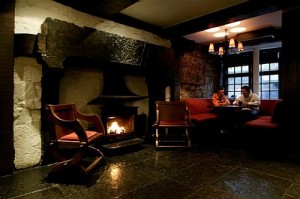 The Kings Head Pub is a true piece of living history dating back over 800 years. Archaeological research has shown that a building was in existence on this site since the 13th century, which is evidenced by the classic burgage plot lay-out. In fact as you walk in the front door of The Kings Head you will notice the date 1612 on the feature fireplace.
The Kings Head Pub is a true piece of living history dating back over 800 years. Archaeological research has shown that a building was in existence on this site since the 13th century, which is evidenced by the classic burgage plot lay-out. In fact as you walk in the front door of The Kings Head you will notice the date 1612 on the feature fireplace.
The earliest pictorial representation of the house occurs in Speed’s famous map of Galway, drawn in 1651`(can we link to a pic of the map). We see a large stone building – featuring a 3 storey dwelling fronting onto the street with a very impressive 5 storey building, known as Bank’s Castle, adjoining it to the rear. It was one of the tallest buildings in Galway, occupying a very prominent position in the centre of the town.
In 1640 the main property at 15 High Street was owned by Thomas Lynch Fitz-Ambrose. By 1654 Lynch Fitz-Ambrose had become Mayor of Galway and was to be the last of 84 successive Lynch Mayors. Following the execution of Charles I on 3rd Jan 1649, Cromwell’s army came to Ireland to assert their authority. One of Cromwell’s most loyal and trusted henchmen, Col. Peter Stubbers, was amongst the commanders who had laid siege to Galway. Following the town’s surrender in April 1653, he became its military Governor. When the Mayor and Corporation of Galway objected to the outrages being perpetrated on the citizens of Galway they were forcibly removed from office by Stubbers in 1654. Stubbers not only removed and replaced Lynch Fitz-Ambrose as Mayor, he seized his splendid house in High Street to boot.
While Col. Peter Stubbers lived at 15 High Street, his neighbour to the rear was the executioner “prime suspect”, Richard Gunning. The belief at the time was that Gunning was given the property as payment for his part in the execution of King Charles I – the “Price of Royal Blood”. He was also making a very successful living by exporting white slaves from Galway to work on his plantation in the West Indies. Gunning was facilitated in this operation by his neighbour Col. Stubbers. This arrangement continued very profitably for both parties until, in 1655, Col. Stubbers, having made himself extremely unpopular, was removed as Governor.
As legend has it Gunning was heard to boast in the Taverns of Galway that his arm “had felt the muscles on the neck of the King of England”. It is more likely however that on that fateful day, 3rd Jan 1649, the man who executed Charles I was in fact Col. Peter Stubbers. Research by Galway historian Jackie Uí Chionna directly links Stubbers to the execution of the King. Following the restoration of the monarchy in 1660, Charles II introduced the Act of Indemnity which pardoned those who conspired against his father. However he specifically exempted Stubbers from this “pardon”. This along with the subsequent “disappearance” of Stubbers makes it extremely likely that he did indeed have a real case to answer. It was a case, then, of “right legend, wrong man!”
In the intervening years the building has had many interesting incarnations from a Gunmakers shop to a Grocer & Spirit dealer until eventually becoming the pub we now know as The Kings Head.
The historical significance of The Kings Head is well documented and becomes clearly evident when you encounter features such as the 1612 fireplace. During renovations in 1996 however, its historical importance was further consolidated when a significant discovery was made. The modern plaster work was removed to reveal two medieval fireplaces, four original cut stone windows and the medieval walls of Bank’s Castle.
Our trip in Ireland was winding down so we went with a traditional lunch at the King’s Head. The Zagman and I had bowl of lamb stew which was great on a windy day. The women went for another plate of fish and chips. 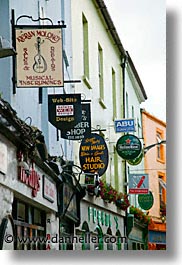
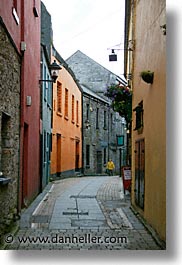 The square was blocked off to traffic but I heard a lot of rumbling about a leprechaun sighting. The Zagman and I were up and down the crowded streets. They said it was the tallest Leprechaun they had ever seen. Then we saw him walking down the street. He looked just like Richard Fox, Gonzaga basketball player. A 7 foot leprechaun from Spokane. Who would have thought we would run into him in Galway?
The square was blocked off to traffic but I heard a lot of rumbling about a leprechaun sighting. The Zagman and I were up and down the crowded streets. They said it was the tallest Leprechaun they had ever seen. Then we saw him walking down the street. He looked just like Richard Fox, Gonzaga basketball player. A 7 foot leprechaun from Spokane. Who would have thought we would run into him in Galway?
Ashford Castle 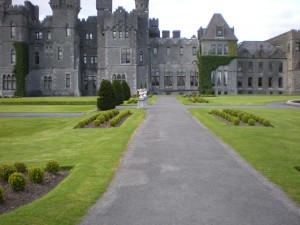 Road to our Room, Knights not visible.
Road to our Room, Knights not visible.
1228 Ashford in Mayo is founded by the Anglo-Norman de Burgo family following their defeat of the native O’Connors of Connaught. the de Burgo’s would build several such castles throughout the province, but Ashford in Ireland would remain the principal stronghold. The native O’Connors also leave a legacy in the form of the nearby 12th century Augustinian abbey of Cong, Co.Mayo, built on the site of a 6th century monastery.
1589
After more than three and a half centuries under the de Burgo’s, Ashford passes into the hands of a new owner. following a fierce battle between the forces of the de Burgo’s and those of the English Lord Bingham, governor of Connaught, a truce is agreed and the castle falls to Bingham who adds a fortified enclave within its precincts.
1715
The famous Ashford estate is established by the Oranmore and Browne family and a fabulous french style chateau is added to the architectural splendour of the castle.
1852
Ashford’s new owner, Sir Benjamin lee Guinness, extends the estate to 26,000 acres, building new roads, planting thousands of trees and adding two large victorian style extensions.
1868
Sir Benjamin lee Guinness bequeaths Ashford to his son, Lord Ardilaun, an avid gardener who oversees the development of massive woodlands and rebuilds the entire west wing of the castle.
1915
Ashford is retained by the Iveagh trust on behalf of the Guinness family until it is bought by Noel Huggard in 1939. Huggard establishes the castle as a “First Class Hotel”
1951 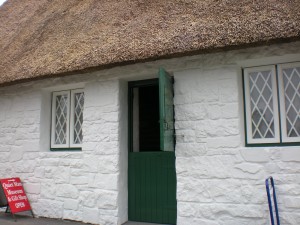 Quiet Man Museum
Quiet Man Museum
The director John Ford comes to the west of Ireland to film what would become a movie classic “The Quiet Man”. Many of the films stars stayed at Ashford and roamed the steets of Cong. (I looked for the King but couldn’t find him.)
1970
Ashford Castle Hotel in Mayo Ireland is bought by John A. Mulcahy who oversees its complete restoration and expansion, doubling its size, building the golf course and developing the grounds and gardens.
1985
A group of Irish American investors purchase Ashford in Mayo. In the 16 years since, Ashford has been voted not only one of the best hotels in Ireland by the most discerning guidebooks, but also one of the top 50 resort properties in Europe.
Dinner in the Dungeon — We looked for our coats and ties but, being unable to find them, we were asked to eat in the Dungeon instead of George V’s dining room.
Plate of sausages, dried meats served with chutneys, mustards.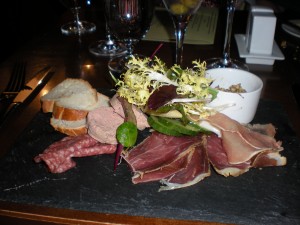
Pork Belly
Oysters with lemon curd, guinness jelly 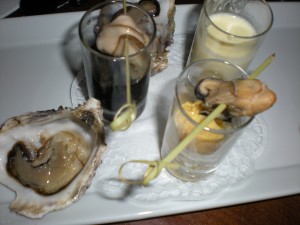
lamb with melted potatoes
Diver scallops
Martini was shaken at the table and the Wine Lady’s gin was brought to the table with the tonic poured after the gin was accepted.
After dinner we went upstairs to the sitting room and listened to Annette Griffin. She studied voice and music at the Royal Irish Academy of Music in Dublin. She has several albums out including songs from Ashford Castle.
Breakfast at the castle
Breads, milks, jams, juices, coffee protectors and a waitress from the Phillipines (no doubt picked up on a raid to that country by one of our warships; a waiter from Bratislava who plays hockey and knew a former Spokane Chief!)
You can go to the Castle site and read about the history. Here are a few highlights and pictures from our visit to the castle that once included seven islands and 22,000 walled acres.
Dublin & Croke Park
Abbey Theater — The Abbey Theatre was founded in 1903 by W. B. Yeats and Lady Augusta Gregory. Its precursors were the Irish Literary Theatre and Frank and Willie Fay’s National Dramatic Society. With patronage from Miss Annie Horniman, premises were purchased on Old Abbey Street and on December 27th 1904, the Abbey Theatre opened its doors for the first time. Is the Pope an ex-Nazi set the tone for the play Alice in Funderland.
Good Friday in Ireland — no beer except in Limerick for the rugby game with Munster. (Fans often ride trains to party on Good Friday because it is legal to drink alcohol on a train.) Also noticed a bottle of Midleton in the Zagman’s bag after we passed through duty free store. Here is a fan on Good Friday. Can’t tell if it is Zagman ornot.
April 6th — New York It’s Greek to Me
Wandered up to Astoria Ditmars for the procession and food. Most people hit New York and start looking for the lady with fire in her hand, the fur on the side of the tall pointed building or stand in line in Times Square waiting to get half price tickets to a revival — none of these things are bad and probably prerequisites on your first visit to NYC (best bet is to take the free ferry to Staten Island and back to see the lady with the torch) but if you have one day where you want to take a breather going to Polish town in Brooklyn, China town in Queens or Little Italy in the Bronx are great options but one that I think is easy and rewarding for a different dinner is to go Astoria Ditmars on the subway and hit a few Greek restaurants. We started with the Greek Salad at Taverna Telly’s while we waited an hour and a half to get into Taverna Kyklades.(and like all restaurants they underestimated the time we would have to wait — this place is very difficult to get into on weekends — no reservations but if you are willing to eat your way through the shops in Greektown it is worth the wait and they will call you on your cell phone if you happen to stop at Marthas and you should happen to stop at Mathas.) We had a dip platter and Greek salad for 6 as our appetizer. The dips were Tzaziki, skordalia (potato and garlic) and a hummus. You can watch them grill whole fish in baskets on their grill while the mother sits in the front of the restaurant taking up a prime table so she can worry about how long you have to wait to get in. Because it is off the beaten path you can probably get a table right away (29th and 23rd — one’s an avenue and the other is just there to confuse you). We walked back to Martha’s Bakery on Ditmars. It was a forty-five minute wait to sit down at 8:00 pm . The bakery was open to 1:00 am so we thought we would go back at 10:00 pm and it was still a half hour wait. They were selling Easter bread with brightly colored Easter eggs on top and Easter cakes. But we came for the pastries. Berry filled Napoleons and Apple Logs (so good they have to be capitalized). We aren’t talking about filling your case with goods from one apple like you see in so many places where a slice of apple pie means a slice of apple in a thick crust in Spokane, these are filled with apples from the middle to the very outskirts of the log and the log isn’t the shape of a tiparillo it is the shape of a country culvert. The apples are crisp, cinnamon from an exotic island off the coast of East Africa and a flaky crust. If you don’t have time for dinner it is worth it to go to Martha’s just to stock up on a few goodies in your room but remember you have to eat the Napoleon’s right away because they don’t use two month shelf cream here, it is the real stuff where when you take a bite you can still hear the cow mooing. The berry custard tarts are heaped with raspberries and blackberries, the cakes and pies have to be measured in feet like half a foot high small apple pie, domed shaped like the White House but with a little more consistency in the ingredients. We waited our hour and fifty minutes and although the gang was willing to leave without eating I insisted not because I was hungry but I didn’t want the gods of Kyklades to win and take my table. We had appetizers and again the prices and portions are amazing here. We started with a spinach pie that was eight inches square and full of cheese and spianch. Not some crusty traingle with slimey spinach in an overcooked phyllo shell. The lamb sausage was three large sausages, splayed out for perfection, spicy and served with lemons; the fried calari is served on a platter, lightly battered with lemons and sause and the dolmathes had a beaurtiful mint tang to the stuffed grape leaf (and I’m talking $7.00 for a platter of dolmathes — fourteen of them). Next table they were being served whole fish (they display the fish with head and bones and then take it away to “off with its head” (I remember that line from Alice in Funderland) and debone; garlic so rich in butter and garlic that the potatoes are almost orange; the Greek salad here is filled with tomatoes, onions, cucumbers, pepperocini, slabs of fresh feta and the garlic bread comes to your table hot, on a platter coated in extra virgin olive oil infused with garlic in and out of the loaf.
April 8 — Millionaire Quartet roams Central Park, Spanish Harlem, The Cloisters, off-Broadway, Little Italy in the Bronx and sleeps through subway stops
Went to TKTS for half price tickets to the 500,000 dollar quarter (I”m assuming they reduce the name of the play as well by 50%). Carl Perkins, Elvis Presley, Johnny Cash and Jerry Lee Lewis getting together with Sam Phillips of Sun Records. Brought together the trip to Memphis for me when I went to the Sun Recording Studio museum.
View from the Cloisters view of the Hudson River.
While walking through Fort Tryon Park we talked to a large man walking three dogs (this was his job — two dalmatian like spotted pudgy dogs and a smaller one, the boss). He suggested we go to a Spanish restaurant on Broadway that Bill Clinton went to for lunch. I’ve found that in general Bill had the credibility (size) and good taste so we headed out to the Spanish restaurant in Spanish Harlem. When we got there it had changed names and a skinny woman walking a dog (her own) asked if she could help. She used to live in the area (her son still does) but she moved to Jersey so she had a bit of a New Jersey tang with a Spanish accent. She started in about the restaurants and then she started sniffing the air and remembered that her favorite was Malecon (another mile) and she dreamily talked about the chickens in the window (kind of like the goose hanging in the window Scrooge saw). She didn’t like the new owners or name so after convincing us easily to go she hailed a cab. Gypsy cabs, gypsy bargaining. She rattled off in Spanish until she got him down to $5 for the ride (no meters here, they just beep their horns going down the street if you want a ride).
At Malecon right away I noticed that they had twelve lunch specials on a Saturday from goat stew to tripe soup. (Every day had ten pluse special — stewed oxtail on Friday, codfish stew on Wed., Caribbean soup on Sunday, etc.) the menu went from appetizers, salads to 7 rice dishes (from chow fan to squid with rice) — did I mention this wasn’t your Taco Bell type Spanish cuisine? 14 Carne dishes (from grilled steak to fried pork chunks and 14 kinds of fish entrees (fried slice king to sea bass in lemon sauce) and 12 seafood dishes from conch meat stew to lobster tail creole and 10 kinds of Mofongos (plantains) from mofongos with plantains and garlic to crab. But all of those chickens hanging in the window led me to the Aves dishes — Chicken Malecon style to ala plancha. I decided to do what the Romans would do and eat Malecon. This was a half chicken, crispy flavorful skin with chimichurri type sauce and moist on the inside. It was served with rice and bean (a separate dinner dish with enough rice for several people and beans) $8.50!! Part of the cloistered group had chicken ala plancha and grilled steak ala plancha served with a dinner plate size salad which had a whole avocago sliced on the cabbage with corn, tomatoes, cucumbers with vinegar and oil cruets to make your own dressing. If you want some Caribbean food go here; if you also like the idea of spending less than $10.00 and getting a great meal order the half chicken Malecon. The other entrees were about $13.00 but these were also a great bargain and it gets you into another neighborhood to learn a little more about the city. And there is no problem with the chickens getting stale in the window. This place was packed at 1:30 on a Saturday afternoon. The waitresses were walking on tip toes to get past each other — piroutetting those half chickens and goat stew bowls.
Roberto’s on Crescent Street (around the corner from Mario’s on Arthur’s Street) was our focus for this trip’s Italian venture.
Sardines with meclum lettuce, fagioli pasta soup, veal braciole, pasta with smoked mussels and scallops, pasta with rapini, olive oil, garlic and linguine with beets, cheese and broccoli rabe
Today we are going to be participants in the Easter Parade if our bonnets are ready. I saw a few dogs getting dressed up for the big day. Even the horses seemed more active last night — smells are a big part of traveling and walking past the horses who have spent years marking their spot on the South end of Central Park is a smell that is hard to forget. I try to avoid it on my way to dinner if possible and you certainly want to avoid it if you have a sensitive stomach after dinner.
We hear there is going to be a strike against Pulitzer and Hearse so we are going down to find out more about it today — Newsies. The movie had batman when he was little in it (Bale).
Unbelievably good weather — another blue sky, temps in the high 50’s although a bit windy for the feathers in my bonnet but that is certainly better than a bee.
Pastrami Queen — If you travel up Lexington Street in New York you come to the Pastrami Queen. This isn’t a place to hang around and eat your Pastrami — one review said there isn’t enough room to swing a cat and that’s a true statement. Small counter with Pastrami that didn’t seem as salty as you get in the some of the delis. It is also a sandwich that you can finish in one seating (although you would be very full). I’m not a fan of a lot of potato salad in NY (too much mayonnaise for me) and this place lived up to my expectations. I thought the Pastrami here is one of the best in the city.
Carnegie Deli — As always they are a bit abrupt here. You do a get a bowl of pickles while you wait for your sandwich and here it is very difficult to finish your sandwich in one seating. The wine lady sipped on Matzoh Ball soup. You can see all of the celebs that have eaten here over the years. Even the names like Woody Allen sandwich give you an idea of the clientele.
Ellen’s Stardust is a lively cafe where all of the waiters and waitresses are aspiring actors. They sing and perform show tunes hoping that the next customer might be a director looking for a new star in their upcoming play. The Zagster ordered their banana split.
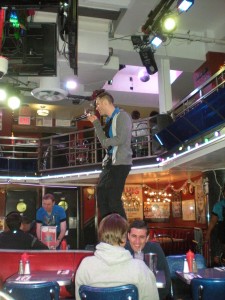 Here you see the offspring of a St. Mary’s basketball family singing on top of a booth, hoping some broadway exec will put him in the next play.
Here you see the offspring of a St. Mary’s basketball family singing on top of a booth, hoping some broadway exec will put him in the next play.
April 9th
Benoit is the creation of Alain Ducasse. Trying to open a bistro in New York this Michelin starred chef has a $30 pre-fixe lunch. Watch them cook at http://www.esprit-bistrot.com/ It is named after the French Brasserie which first opened its doors in Paris in 1912. You can get escargots, pate en croute, duck foie gras terrine, charcuterie and pates and Maine lobster salad at lunch and then have a main course of steamed loup de mer with fennel, sweet onions and lavender or a foie de veau (calf liver with Lyonnaise potatoes and slow-simmered onions) or a hamburger with pommes frites. The Wine Lady went with Sea Bream and the Librarianess went with Shepherd’s pie and a cheese souffle.
Two Boots is the result of two more aspiring artists who opened a pizza place when they hadn’t made their fortune on broadway. We stopped in to get a fix for our slice of pizza. You can get Chicken, Broccoli, Garlic & Basil Pesto pizzas or The Newman (sopressata & sweet Italian sausage on white pie) this had a lot of flavor and I would order it again or a Bayou Beast with BBQ shrimp, crawfish, andouille, jalapenos and mozzarella. They feature San Marzano tomato sauce and a large selection of vegetables.
Living Room is a bar about a block and a half from Katz’s deli on Ludlow street. You walk in and it smells musty. Behind heavy curtains is a rather rundown room with a stage. What goes on stage is not dilapidated. They have a series of groups each night playing acoustic to jazz. We went to see Serena Jost introduce her new album to the audience. She was backed up by my Harvard friend’s son, Robert Jost (no relation, they don’t even pronounce their last name the same J vs Y). Robert has appeared in many groups in NY and was the guitarist on SNL during the Sarah Palin shows. Currently he is a regular on the Muppet Show and plays in several groups around the city including the Tony Sherr trio which currently is playing Mondays at the Living Room.
Brick Lane Curry House — curry in the East Village. Brick Lane offers a number of different curry preparations including Phal (excruciating hot, you have to give a verbal commitment before you order that you won’t hold them responsible for the heat and the chef wears a gas mask while preparing it!! You get a free beer if you finish it.) Even the regular curries are hot here but not so much you can’t enjoy the flavors.
Haveli — around the corner from Brick Lane is Haveli.It is patterned after an Indian Haveli — a residential mansion with a partially elevated second floor and interior courtyard. They feature several curries that include beef, lamb, chicken or keema like the Dildar cooked with fresh pineapple or Mottor cooked with green peas or Dansak Curry with lentils and hot spices Persian style.
Dean and Deluca— I like to go here for coffee and pastry, maybe pick up a baguette to go. Another food museum in NY it is one of my favorite things to hop on the subway (unlimited pass) and go down for a coffee and smell the market. They are famous for their macaroons but I trend towards the apple tarte tartin or hazelnut pear frangipane tart or cherry clafouti. It is an indulgence but a great way to start the day.
And so you have the latest version of on the road. As always it is exciting to see how other parts of the world live and to test myself on how I might react to those experiences. At times, there are even things to share.
Where is Joel Godot Huppin? He said he would play me a match any place, any time.

